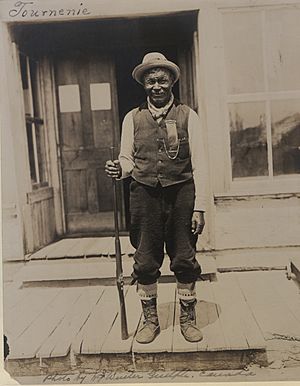Ignace Tonené facts for kids
Quick facts for kids
Ignace Tonené
|
|
|---|---|
| Maiagizi | |

Tonené in 1909
|
|
| Born | 1840 or 1841 Near Lake Temagami
|
| Died | 1916 |
| Nationality | Temagami First Nation |
| Employer | Hudson's Bay Company |
| Known for | Teme-Augama Anishnabai leadership |
Ignace Tonené (1840/1841 – 1916), also known as Nias and Maiagizis, was a Hudson's Bay Company employee, a fur trader, a gold prospector, and the chief of the Teme-Augama Anishnabai community.
Tonené was the elected deputy chief before being the lead chief and later the life chief of his community. In his role as deputy, he negotiated with the federal and provincial governments for his community to receive annual financial support from them. His attempts to secure land reserves for his community were thwarted by Ontario premier Oliver Mowat.
Tonené's gold prospecting triggered a 1906 staking rush and his own stake led to the creation of the Kerr Addison gold mine, although his stake was stolen from him by European settlers.
Contents
Early life
Tonené was born in 1840 or 1841 near Lake Temagami in the Teme-Augama Anishnabai community of the Temagami First Nation in what British settlers knew as Upper Canada. He was the eldest son of François Kabimigwune and Marian.
Career and community leadership
Tonené worked for the Hudson's Bay Company, delivering mail between its trading posts at Lake Timiskaming and Lake Temagami. He also worked at Fort Témiscamingue where he likely learned French.
Temagami leadership
Around 1868, Tonené was elected to succeed his father as the anike ogima (English: deputy-chief) and he became the head chief in 1878. As the anike ogima, Tonené raised the issue of his community's exclusion from the 1850 Robinson Treaty between European settlers and Ojibwa nations around Lake Huron. Tonené, with two associates, met Charles Skene, a federal Indian agent to explain their concerns about arriving lumberjacks and that they sought an annuity and a reserve, since their people's land had not been ceded to the Canadian government. During a January 1st, 1879 speech, Tonené warned his community: “the white men were coming closer and closer every year and the deer and furs were becoming scarcer and scarcer...so that in a few years more Indians could not live by hunting alone.”
He continued to press for federal financial support and the creation of a reserve through a series of meetings and letters written both in English and Anishinaabe, which resulted in an acknowledgement from Lawrence Vankoughnet in 1880 that approximately 2,700 square miles of Temagami land was indeed unceded. Canadian Prime Minister John A. Macdonald deferred the matter to the Ontario Premier as land claims were provincial government, rather than a federal issue, although in 1883 the Department of Indian Affairs agreed to an annual payment to the nation comparable to the amount other first nations included in the Robinson-Huron Treaty were receiving.
In 1884, Tonené convened a tribal council on Bear Island to discuss the potential location for the reserve, which he proposed to be about 100 square miles around Cross Lake and the south end of Lake Temagami. The community agreed. The federal government agreed to the proposal, but the Ontario premier Oliver Mowat, who was known to be hostile to Indigenous treaty rights, blocked the land transfer.
In 1888, after Oliver Mowat's refusal to create the reserve, Tonené moved his family to land between Lake Opasatica and Lake Dasserat near Abitibi, Quebec. In 1889, he travelled to Bear Island to ask the Indian agent for agricultural supplies for his community. During the journey, Tonené fed his family by hunting and trapping and, motivated by the discovery of silver at Cobalt, Ontario, prospecting.
Tonené's prospecting became so good that the Canadian Mining Journal credited him with instigating the Larder Lake gold rush of 1906. He discovered the ore body that became the Kerr Addison gold mine at McGarry, but his claim was stolen from him. The Indian Act of 1876 prevented Tonené from hiring a lawyer.
Tonené was succeeded as head chief by John Paul, though Tonené continued to hunt and trap in Abitibi country. When John Paul died in 1893, Tonené reverted back into the head chief role, and from 1910 he was the honorary or life chief and the primary advisor to the new head chief, his younger brother Frank White Bear.
Personal life
In the 1870s, Tonené married Angèle, the daughter of former Temagami band chief Nebenegwune. They had two sons and two daughters and she died giving birth to their youngest child in 1869. In 1871, Tonené married Elisabeth Pikossekat of Timiskaming band and they had three daughters.
All of Tonené's sons died before adulthood, although his five daughters all lived into adulthood, married and had children.
Death and legacy
Tonené died in 1916 and was buried close to Mount Kanasuta on the Quebec-Ontario border. The location of his burial was later turned into a gravel pit and then a community dump.
The lake south of Bear Lake is now known as Chief Tonené Lake.

